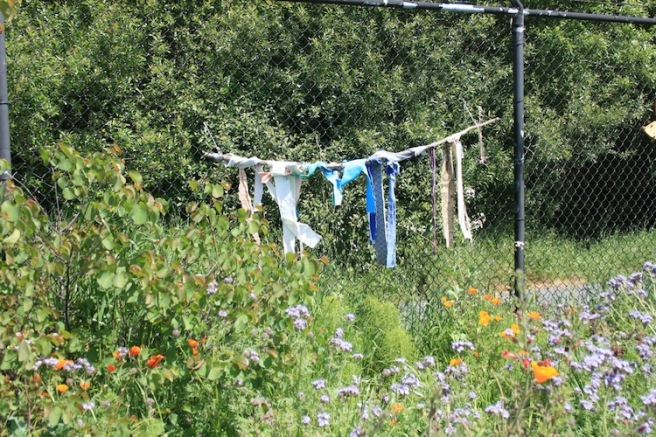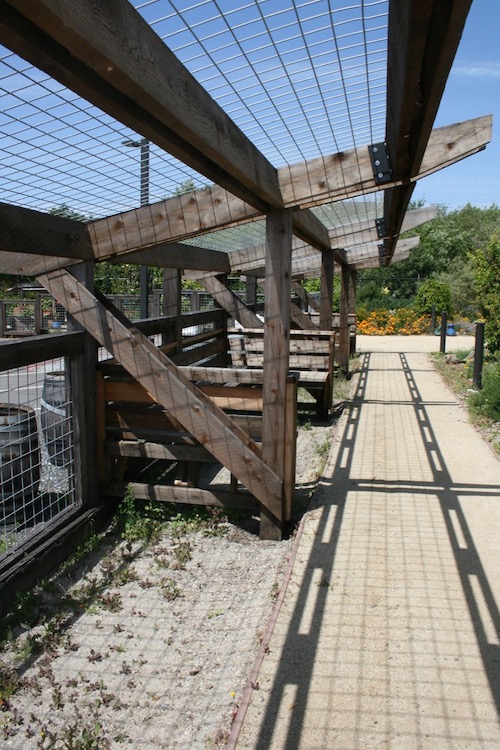The last day of my long Bay Area weekend was devoted to a Garden Conservancy Digging Deeper program at Berkeley community farm Urban Adamah.

Urban Adamah was founded in 2010 by Adam Berman as the first urban Jewish community farm in the United States. The farm’s seeds are rooted in a Connecticut farm-based residential leadership program. Adam envisioned an urban farm that would provide a fellowship program, offer Jewish agriculturally based experiential programs for youth and families, and contribute to food security in the East Bay. The farm moved in 2016 to its permanent home near Codornices Creek in Northwest Berkeley after five years in a temporary location. The word adamah in Biblical Hebrew means ground or earth.

A little hard to decipher as the metal sign over the entrance has aged–it reads “Love…all the rest is commentary”.
Berkeley artist and landscape designer Keeyla Meadows was brought in to design a city required swale when the 2.2 acre parcel was a blank slate. She went on to design the Pollinator Garden, the Children’s Garden and work with staff as other parts of the garden have been developed. Keeyla (on the left below) and Emily, the Urban Adamah Landscape Coordinator were our guides.

We gathered in the center of a large circular planting bed to learn a bit about the farm’s history and philosophy. The core tenants of Urban Adamah are stated in this Mission Statement: “Urban Adamah seeks to build a more loving, just and sustainable world. We ground and connect people-to themselves, to others, and to the natural world. We do this by providing farm based, community building experiences that integrate Jewish tradition, mindfulness, sustainable agriculture and social action.”

Keeyla points out that almost every area of the farm has a central open area designed for small groups of people to meet and build relationships. This was a specific request made by Urban Adamah’s founder–places to gather as a community must be plentiful, welcoming and comfortable. The farm is open to the public most week days and is a lovely environment in which to enjoy the outdoors and observe nature at work–plus volunteer workers are welcome! We will explore most of the farm’s major areas, stopping to observe the plantings and ask questions as Keeyla and Emily share the design philosophy and challenges in developing this very young garden.

We start at the Blueberry Meeting Circle where a ring of sturdy upright logs provide both seating for us and a podium for Keeyla.

Without sharp eyes you might miss the ring of blueberries planted around the meeting circle, nestled amongst freely self sowing California poppies. Several native penstemons, blue-eyed grass and salvia also make their home here along with many Douglas iris.

Gardeners are good multi-taskers. As Keeyla describe the soil building and design process for this area, one of our group pulls weeds as she listens. The farm is organic and weeding is a never ending task, especially in areas where self-sowers are allowed to have their way.
The Blueberry Meeting Circle is a charming front garden to the Aquaponic House where four levels of plants are stacked, producing lettuces, basil and other leafy greens.


This buttery lettuce is planted with only a small amount of bark like material and its roots reaching down into the water below.
The bottom trays now hold a variety of plants being grown for their leaves textural experience, such as the gigantic Gunnera leaf and the surprising soft, almost furry, leaf of its neighbor.

This tank is home to fish whose waste provides the natural fish emulsion nutrients to the plant via the circulation system of pipes.
We circle out of the Aquaponics House and return to the Blueberry Meeting Circle, a great vantage point to see the full length of the Urban Swale. the farm is adjacent to Codornices Creek which is in the midst of a civic restoration plan. The city of Berkeley required the installation of a swale on the farm’s property to prevent runoff of both rainwater and farm waste water into the creek.

The Urban Swale, planted entirely in California natives runs from just beside the Blueberry Meeting Circle and along the farm’s front fence line almost to the entry gate.

Hooker Creek boulders and Sonoma stone were brought in to form the bank stabilizing structure of the swale. Plantings were designed in repeating color bursts to keep your eye moving down the length of the swale. Keeyla calls this ‘weaving color’ throughout a space. Native plants requiring more moisture are planted lower on the bank while the more drought tolerate plants are higher up. The shape of the swale allows accumulated water to percolate slowly back into the ground. Keeyla’s choice of native plantings in part was to relate the swale to the creek and to honor the area’s indigenous peoples and their stewardship of the land.


Several varieties of California poppies were included in the original sowing of reseeding annuals. Subsequent seasons have produced some interesting color variations as the result of natural hybridization.




As we walk to the far side of the farm to see the Pollinator Garden, Emily shares that this Administration Building was the first permanent structure built on the site; a great accomplishment after five years of a trailer office. The passionflower vines on the office trellises (and on the fences in the Urban Swale) were a concession to a former farm colleague who was instrumental in the early planning days. He loves passionflowers and would regularly harvest the fruit for use in tea and other edibles.

Urban Adamah gives away 90% of the food it grows. The remainder is used on the farm for events and for use by residents of the farm. They host a weekly farmer’s market for anyone who needs food. Local grocery stores, including Whole Foods, contribute goods not yet produced on the farm. At any given times throughout the year they will produce all kinds of vegetables, herbs, stone and pomme fruits, potatoes, onions, eggs and milk.


Crops are rotated regularly–vetch, Fava beans and crimson clover are planted as nitrogen fixing cover crops to be tilled back into the ground (after bean harvest, of course).


The Pollinator Garden is our next stop–a melange of seasonal veggies surrounded by plants chosen specifically for their attraction of certain pollinators. Emily worked closely with Keeyla on the implementation of the design and credits this garden as awakening her desire to not only plant, but also be a designer. As we visit not much is in prime bloom. Emily explains what different shapes and colors are attractive to specific kinds of pollinators–tubular for the hummers vs flat for the butterflies, etc.–and the importance of having something for everyone if you want to maximize pollination.

The Children’s Garden entrance is home to arbor seating–I haven’t been counting seating areas but I’m sure there at least 10. A young vine is on its way up to give visitors some shade while they get to know each other.
Urban Adamah has a full schedule of family friendly activities, including summer camp. The goals for children are the same as for adults; to build community; to foster Jewish traditions; to learn and practice sustainable agriculture and living.

The Children’s Garden is only a stone’s throw from the creek and has its own swale to serve the same purpose as the first built Urban Swale. Keeyla also designed this garden and the swale is similar in planting with the exception of possibly more native wildflowers–sowing seeds is a popular activity on this side of the farm. Here you can see the swale emerging from under the bridge to the Earthbench meeting place.

With the guidance of an educator from the Peace on Earthbench Movement (POEM) children built this garden gathering space using plastic bottles and other recycled materials over several camp sessions. Locally based POEM’s international mission is to encourage youth to turn plastic waste into artistic community gathering places. This is a project I would want to participate in–what fun!

Looking down the Children’s Garden swale you see art created by children and displayed on the fence.


Leaving the Children’s Garden we pass a newly constructed grape arbor tucked up against the street side fence.


As yet unplanted, the arbor will be home to several grape varieties (you can see the barrels just outside the fence awaiting the vines) for a nascent partnership with the kosher winery directly across the street. The structure was built by local Eagle Scouts–notice every section has seating for several people.
We make a quick detour to the goat pen to meet Lev and Ivy and give them a snack pulled right from the field–and right in front of the Do Not Feed the Goats sign.
These two clearly recognize Emily and know she comes with goodies. They will not let her out of their sight!
On our way to talk about the Seven Sacred Species Garden we stop for a brief art activity. Keeyla has provided us with paper, colored pencils and markers, and string and asks us each to make a wish or a prayer to hang on the farm’s olive tree, telling us our thoughts will be released into the wind. The olive tree is the farm’s focal point, visible as soon as you enter the gate. A universal symbol of peace and one of the Seven Sacred Species, this tree was 42 years old when it was selected for the farm 18 months ago and the variety is one preferred for its oil. It actually sits mounded high because the farm’s electrical and water utilities are underneath it. Rocks were added to stabilize the raised planting area. I’m not sure how much of an olive oil crop you can get from one tree but I’m giving the farm extra credit for covering all the bases.
Had to make a quick trip back to the goat pen to retrieve an errant paper prayer from Ivy!

The Seven Sacred Species are plants which deeply link spiritual beliefs to the natural world and play prominent roles in the Bible. They are olive, fig, date, wheat, barley, grapes and pomegranate. It was important to the farm’s founder to include these species on the farm and at this writing they have 6 of the seven, lacking only barley.
Several are represented around the entry gate.



There is a lone date palm near the Blueberry Meeting Circle and wheat planted in the crop beds. It is fitting that these species closely linked with the Bible would be at home in this place deeply rooted in Jewish traditions.
Our group had thinned a bit by now–many, including me, did not know the extent of the experience and had planned for less time. Those of us remaining took a break to gather fresh herbs, berries, greens and edible flowers to add to salad ingredients Keeyla had provided.



Keeyla had made grape leaf dolma stuffed with barley and currents, polenta, small white pastries with dates, and a blueberry tart. A wonderful challah was the highlight for me–delicious.

We filled our plates and gathered at a circle of benches to break bread and get to know each other a little better–exactly what Urban Adamah founder Adam Berman would have wanted.
This day was a wonderful experience and I would encourage anyone in the vicinity of Urban Adamah to take a few minutes to see the farm. I will close with a few more photos and several websites for you to get more information if you desire.
Here we go–
For more information about Urban Adamah, its mission and programs go to http://www.urbanadamah.org
For more information about Keeyla Meadows, her art, books and gardens go to http://www.keeylameadows.net
For more information about Garden Conservancy Digging Deeper programs go to http://www.gardenconservancy.org then click on Open Days, then Digging Deeper
For more information about the Peace on Earthbench Movement go to http://www.earthbench.org


















3 thoughts on “Digging Deeper with Keeyla Meadows at Urban Adamah…”